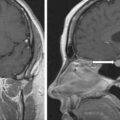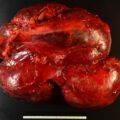Multiple endocrine neoplasia type 2B (MEN2B) is an autosomal dominant disorder with age-related penetrance, and it represents approximately 5% of all MEN2 cases. MEN2B is characterized by medullary thyroid carcinoma (MTC) in all patients, adrenergic (epinephrine and metanephrine predominant) pheochromocytoma in 50%, mucocutaneous neuromas (typically involving the tongue, lips, and eyelids) in most patients, and by skeletal deformities (e.g., kyphoscoliosis, lordosis), joint laxity, myelinated corneal nerves, and intestinal ganglioneuromas. , MEN2B-associated tumors are caused by mutations in the rearranged during transfection (RET) protein’s intracellular domain. A single methionine-to-threonine missense pathogenic variant in exon 16 (p.Met918Thr; c.2753T>C) of the RET protooncogene is responsible for more than 95% of MEN2B cases. Another pathogenic variant, alanine to phenylalanine at codon 883 in exon 15 of the RET protooncogene, has been found in 4% of MEN2B cases.
Case Report
The patient was a 19-year-old man who had been troubled by episodic tachycardia of 10 minutes duration and occurring every other day for the past 1 year. At age 12 he was diagnosed with MEN2B when an ophthalmologist detected enlarged corneal nerves, which led to germline genetic testing that documented a pathogenic variant in the RET protooncogene (p.Met918Thr; c.2753T>C). As with most patients with MEN2B, no one else in the family carried the mutation. , Other stigmata of MEN2B were clearly evident, including mucocutaneous neuromas of the lips and tongue ( Fig. 46.1 ). At age 12 he underwent thyroidectomy for bilateral multicentric medullary thyroid carcinoma (MTC). Four lymph nodes contained metastatic MTC. The preoperative serum calcitonin concentration was 970 pg/mL and after surgery it improved to 41 pg/mL (normal, <15.9 pg/mL). At 15 years of age he underwent right adrenalectomy for multifocal pheochromocytoma (2 × 1.5 × 1.2 cm and 0.5 cm). He took no regular medications. What was of the most concern to the patient was the tongue mucocutaneous neuromas that were a constant irritation because he would inadvertently bite them. His blood pressure was 118/55 mm Hg, heart rate 68 beats per minute, and body mass index 18.6 kg/m 2 .

INVESTIGATIONS
Preoperative laboratory studies are shown in Table 46.1 . The levels of metanephrine in the blood and urine were diagnostic of an adrenergic pheochromocytoma. Serum calcitonin was elevated at 168 pg/mL (normal, <15.9 pg/mL) and consistent with metastatic MTC. Adrenal computed tomography (CT) scan showed a multinodular left adrenal gland ( Fig. 46.2 ). Neck ultrasound and CT of the chest, abdomen, and pelvis did not localize the sites of persistent MTC.
| Biochemical Test | Result | Reference Range |
| Sodium, mmol/L | 141 | 135–145 |
Potassium, mmol/L | 4.2 | 3.6–5.2 |
Creatinine, mg/dL | 1.1 | 0.8–1.3 |
Plasma metanephrine, nmol/L | 1.47 | <0.5 |
Plasma normetanephrine, nmol/L | 1.38 | <0.9 |
Serum calcitonin, pg/mL | 168 | <15.9 |
24-Hour urine: | ||
Metanephrine, mcg | 490 | <400 |
Normetanephrine, mcg | 328 | <900 |
Norepinephrine, mcg | 28 | <80 |
Epinephrine, mcg | 4.5 | <20 |
Dopamine, mcg | 182 | <400 |
Stay updated, free articles. Join our Telegram channel

Full access? Get Clinical Tree








